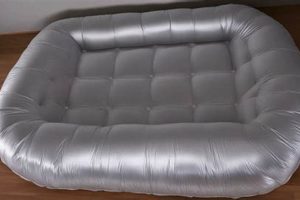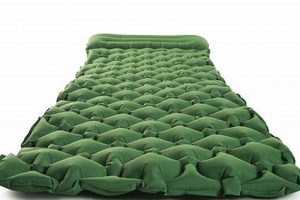An intermittent, sharp sound emanating from an inflatable mattress, often described as a “pop,” generally indicates internal stress or a change in pressure within the air chamber. This phenomenon arises from several potential causes, all related to the material’s response to forces exerted upon it. The frequency and intensity of these sounds can vary depending on the nature of the underlying issue.
Understanding the origin of such noises is important for maintaining the longevity and functionality of the air mattress. Identifying the cause early can prevent further damage, such as leaks or structural failures, thereby preserving the investment in the product. Historically, manufacturers have sought to address this issue through improved material science and construction techniques, focusing on enhanced durability and reduced stress points.
This article will explore the various factors contributing to these sounds, including temperature fluctuations, overinflation, material fatigue, seam weakness, and external pressures. It will also offer potential solutions and preventative measures to mitigate this issue and ensure the continued usability of the inflatable mattress.
Troubleshooting Air Mattress Sounds
The following recommendations address mitigating unusual auditory emissions originating from inflatable mattresses.
Tip 1: Regulate Inflation Levels: Over-inflation creates excessive internal pressure. Consult the manufacturer’s instructions for optimal inflation levels. Use a pressure gauge if provided, and avoid filling the mattress to its maximum capacity, particularly in warm environments where air expands.
Tip 2: Monitor Environmental Temperature: Temperature fluctuations affect air volume. Cooler temperatures cause air contraction, potentially resulting in discomfort. Warmer temperatures lead to air expansion, increasing internal pressure and the likelihood of stress noises. Adjust inflation as needed based on room temperature.
Tip 3: Inspect Seams and Valves: Thoroughly examine the mattress’s seams and valve areas. Weakened seams or faulty valves are potential sources of air leakage and subsequent sounds. Use soapy water to check for small leaks, indicated by bubble formation. Repair any identified leaks using manufacturer-recommended patching kits.
Tip 4: Distribute Weight Evenly: Uneven weight distribution creates localized stress points. Ensure the mattress is placed on a level surface free of debris. Rotate the mattress periodically to distribute wear across its entire surface.
Tip 5: Utilize Protective Layers: Employ a mattress protector or pad. These additions provide a buffer against friction and sharp objects, minimizing potential damage to the mattress material and reducing stress on seams.
Tip 6: Check for Obstructions: Ensure there are no objects beneath or around the mattress that could be pressing against it, creating pressure points. This is especially important if the mattress is placed on a bed frame or near other furniture.
Implementing these strategies can significantly reduce the occurrence of noise and prolong the lifespan of the air mattress.
The final section will address advanced troubleshooting and when professional repair or replacement may be necessary.
1. Over-Inflation
Over-inflation represents a primary cause of stress-induced auditory emissions in air mattresses. When an air mattress is filled beyond its recommended capacity, the internal pressure exerted on the material exceeds its design limits. This excess pressure places significant strain on the mattress’s seams, internal baffles (if present), and the material itself, potentially leading to a sudden, sharp release of pressure, perceived as a “pop.” In essence, the material is stretched beyond its elastic limit, and the resulting noise signifies the material yielding, however minutely, under that stress.
The consequences of over-inflation extend beyond mere noise. It accelerates material fatigue, shortens the lifespan of the mattress, and increases the likelihood of seam failure, resulting in air leaks. For instance, a common scenario involves individuals inflating their mattress to maximum firmness without considering ambient temperature. As room temperature rises, the air inside the mattress expands, further elevating internal pressure and exacerbating the risk of popping sounds and structural damage. Therefore, adhering to the manufacturer’s inflation guidelines is crucial for preventing such occurrences. Ignoring these guidelines can lead to irreversible damage, negating any perceived benefit of a firmer sleeping surface.
In conclusion, understanding the connection between over-inflation and the generation of popping sounds in air mattresses is paramount for responsible usage. Regular monitoring of inflation levels, particularly during temperature fluctuations, and diligent adherence to manufacturer’s recommendations are essential preventative measures. While seemingly minor, these actions can substantially prolong the lifespan of the mattress and maintain its structural integrity, precluding the need for premature replacement. The popping sound serves as an auditory warning, indicating that the mattress is operating under undue stress and requires immediate attention to prevent further damage.
2. Temperature Fluctuations
Temperature fluctuations significantly influence the internal pressure of air mattresses, directly contributing to the occurrence of popping noises. Air density is inversely proportional to temperature; therefore, as ambient temperature increases, the air within the mattress expands. This expansion increases internal pressure, placing stress on the mattress material and seams. Conversely, a decrease in temperature causes air to contract, potentially creating slack in the material, although this is less likely to produce audible popping compared to expansion. The popping noise results from the material yielding to increased pressure, or from seams shifting as a response to these pressure changes.
The magnitude of temperature-induced pressure changes is proportional to the initial volume of air and the extent of the temperature variation. For example, an air mattress fully inflated in a cool environment and subsequently exposed to direct sunlight or a heated room will experience a considerable increase in internal pressure. This is particularly relevant in outdoor scenarios, such as camping, where daytime heat and nighttime coolness can create a pronounced pressure cycle. Failure to account for these temperature-driven pressure variations can lead to over-inflation during warmer periods and subsequent material fatigue or seam failure. The effect of this stress contributes to the instances of an air mattress creating the “popping noise” referred.
In conclusion, temperature fluctuations are a key factor contribu
ting to pressure variations within air mattresses, thereby influencing the incidence of audible popping. Mitigating this phenomenon requires proactive management of inflation levels, considering the expected temperature range. Venting a small amount of air during periods of warming and adding air during cooling cycles can help maintain optimal internal pressure and reduce the likelihood of material stress and associated noises. Understanding and actively managing these thermal effects is essential for prolonging the lifespan and functionality of inflatable mattresses. Ignoring the effect of temperature fluctuations can result in the question: “Why is my air mattress making popping noise?”, and can potentially lead to irreversible damage.
3. Material Degradation
Material degradation within air mattresses represents a critical factor contributing to structural instability and the subsequent emission of popping noises. The gradual deterioration of the mattress’s constituent materials compromises its ability to withstand internal pressure, rendering it susceptible to stress-induced failures and auditory manifestations.
- Polymer Breakdown
The primary material in most air mattresses, typically PVC or similar polymers, undergoes degradation due to ultraviolet (UV) radiation exposure, oxidation, and hydrolysis. UV exposure breaks down polymer chains, reducing flexibility and increasing brittleness. Oxidation and hydrolysis, facilitated by moisture and air, further compromise the material’s integrity. This breakdown leads to a weakening of the overall structure, predisposing the mattress to popping sounds as the weakened material yields under pressure.
- Plasticizer Loss
Plasticizers are added to PVC to enhance its flexibility and durability. Over time, these plasticizers can leach out of the material, either through evaporation or migration, especially under elevated temperatures or with repeated flexing. This loss of plasticizers results in a stiffening and embrittlement of the PVC, making it more prone to cracking and tearing. The popping sound can then occur as the inflexible material is stressed beyond its reduced elastic limit during inflation or use.
- Seam Weakening
The seams of an air mattress, often welded or glued, are particularly vulnerable to material degradation. The adhesives used may degrade over time, losing their bonding strength. The surrounding material may also weaken due to stress concentration at the seam. This degradation can lead to partial or complete seam failure, manifested as popping noises as the compromised seam gives way under pressure. Small leaks can also develop due to seam degradation, which can be heard as hissing or crackling, potentially preceding a more significant popping sound as the leak worsens.
- Fungal and Microbial Growth
In humid environments, air mattresses can become breeding grounds for fungi and microbes. These organisms can secrete enzymes that break down the polymer structure, accelerating material degradation. The resultant weakening of the material, particularly if localized, can lead to popping sounds as the compromised area is subjected to stress. The presence of microbial growth can also generate odors and discolorations, indicative of significant material damage.
The cumulative effect of these degradation processes substantially increases the likelihood of “popping noise” during air mattress usage. Regular inspection for signs of material damage, such as discoloration, stiffness, or seam separation, is crucial. Proper storage, away from direct sunlight and extreme temperatures, can help mitigate these degradative processes. When material degradation becomes extensive, repair may no longer be feasible, necessitating replacement of the mattress to ensure safe and comfortable use. Neglecting the consequences of material degradation increases the chance of catastrophic failure, and subsequently, the question: “why is my air mattress making popping noise?”
4. Seam Stress
Seam stress represents a significant contributor to the phenomenon of audible emissions originating from inflatable mattresses. These sounds, often described as popping noises, are frequently indicative of structural compromises within the mattress’s construction. Seams, being the junctures where separate pieces of material are joined, inherently experience concentrated stress when the mattress is inflated and subjected to weight. Manufacturing defects, design flaws, or degradation of the bonding agent can exacerbate this stress, leading to premature seam failure and associated auditory manifestations. For example, if an air mattress has a poorly welded seam in a high-stress area like the center, that area may give way as the pressure builds in the mattress. A mattress with a single chamber rather than an intelligently baffled multi-chamber design will have higher pressure at the seams because the pressure cannot be distributed, increasing risk of failure.
The magnitude of seam stress is directly proportional to the internal pressure of the mattress and the weight it supports. Over-inflation amplifies the stress experienced by the seams, increasing the likelihood of failure. Uneven weight distribution further concentrates stress on specific seam sections, accelerating the degradation process. The material composing the mattress also plays a role; thinner or lower-quality materials offer less resistance to stress, making seams more vulnerable. The orientation of seams relative to the direction of stress also matters; seams aligned perpendicular to the primary force vector are generally more susceptible to failure than those aligned parallel.
Recognizing the connection between seam stress and the generation of popping sounds is crucial for preventative maintenance and extending the lifespan of inflatable mattresses. Avoiding over-inflation, ensuring even weight distribution, and selecting mattresses constructed from durable materials with robust seam construction are essential strategies. Regularly inspecting seams for signs of wear, such as fraying, separation, or discoloration, can facilitate early detection of potential problems. Failure to address seam stress can lead to catastrophic mattress failure, rendering it unusable. Therefore, a proactive approach to mitigating seam stress is paramount for preserving the integrity and functionality of inflatable mattresses and preventing the occurrence of the question: “why is my air mattress making popping noise?”.
5. Uneven Support
Uneven support beneath an air mattress introduces localized stress concentrations, significantly contributing to the occurrence of popping noises. When an inflatable mattress rests on an irregular surface, certain areas bear a disproportionate share of the load, exceeding their designed capacity. This imbalanced distribution of weight generates tensile forces within the mattress material, particularly at the points of contact with the supporting surface. The consequence is a heightened risk of material fatigue, seam separation, and ultimately, the emission of audible popping sounds indicative of structural strain. The integrity of the air mattress is undermined, as sections of the material overextend while othe
r regions remain relatively unstressed. This differential strain pattern accelerates wear and tear, predisposing the mattress to premature failure. The audible pop is a result of sections giving way under too much pressure. A pebble beneath one area of the mattress can cause a pop when the edge of the mattress on that section experiences significant weight.
The composition of the supporting surface directly influences the severity of this effect. For instance, placing an air mattress on a slatted bed frame with wide gaps between the slats concentrates pressure on the points of contact. Similarly, debris present beneath the mattress, such as small rocks or sharp objects, creates localized stress raisers, amplifying the likelihood of damage and associated noises. Even seemingly minor imperfections in the supporting surface can initiate a cascade of stress accumulation, eventually leading to observable material degradation and the characteristic popping sound. The presence of a mattress protector or pad can offer a limited degree of cushioning, but it cannot fully mitigate the adverse effects of a fundamentally uneven support structure. The presence of internal supports can also effect support, but this is not directly related to external support.
In summary, uneven support represents a critical factor in the emergence of popping noises from air mattresses. Ensuring a uniform and level supporting surface is paramount for maintaining the mattress’s structural integrity and prolonging its lifespan. Addressing irregularities in the supporting surface, removing debris, and employing a solid foundation are essential preventative measures. Ignoring the impact of uneven support accelerates material fatigue, concentrates stress on seams, and increases the propensity for audible popping noises, ultimately leading to premature mattress failure. The importance of solid foundation in the avoidance of “why is my air mattress making popping noise” is very apparent.
6. Valve Malfunction
Valve malfunction in inflatable mattresses can manifest as subtle air leakage or catastrophic failure, both of which may be accompanied by unusual auditory emissions. While not always a direct source of popping sounds, a compromised valve can indirectly contribute to pressure imbalances and material stress, ultimately leading to conditions where popping noises occur.
- Gradual Air Leakage
A valve that fails to seal completely allows air to escape gradually. This leakage necessitates frequent re-inflation to maintain desired firmness. The repeated expansion and contraction of the mattress material due to this cycle of inflation and deflation induces stress, particularly on the seams and surrounding material. The resulting material fatigue can cause small, sudden shifts within the mattress structure, manifesting as popping noises. The gradual loss of air increases the rate of wear within the mattress.
- Sudden Valve Failure
A valve may fail abruptly, releasing a significant volume of air rapidly. This sudden decompression creates a pressure differential within the mattress, potentially causing internal baffles (if present) to shift or tear. The rapid movement of these internal structures, or the sudden contraction of the mattress material itself, can generate a distinct popping sound. This is particularly relevant in mattresses lacking robust internal support structures.
- Valve Body Damage
Physical damage to the valve body, such as cracks or fractures, can compromise its sealing integrity. Even minor damage can lead to air leakage and subsequent material stress, as described above. Furthermore, damaged valve components may themselves produce clicking or popping sounds as they move under pressure. These sounds may be misattributed to the mattress material itself, obscuring the true source of the problem. The damaged portion gives way as the matrix applies stress, causing sound.
- Debris Interference
The presence of foreign debris within the valve mechanism can prevent a complete seal, leading to air leakage. Small particles of dust, dirt, or fabric can obstruct the valve’s internal components, compromising its ability to maintain pressure. The act of attempting to close a valve with debris present can sometimes generate clicking or snapping sounds, which may be confused with popping noises originating from the mattress material.
In summary, while a malfunctioning valve is not always the direct cause of popping noises, it can significantly contribute to the conditions that promote their occurrence. Air leakage, whether gradual or sudden, induces stress and fatigue within the mattress material, increasing the likelihood of structural failures and associated auditory emissions. Addressing valve issues promptly is therefore crucial for maintaining the integrity of inflatable mattresses and mitigating the underlying causes of “why is my air mattress making popping noise”.
Frequently Asked Questions
The following section addresses common inquiries regarding unusual noises emanating from air mattresses, providing concise and informative responses to assist in troubleshooting and preventative maintenance.
Question 1: What is the primary cause of popping noises originating from an air mattress?
The most frequent cause is internal stress resulting from over-inflation, temperature fluctuations, or uneven weight distribution. These factors create pressure imbalances that exceed the material’s capacity, leading to audible releases of tension within the structure.
Question 2: Can temperature changes affect the likelihood of these noises?
Yes, temperature variations directly impact air pressure inside the mattress. Elevated temperatures cause air expansion, increasing internal pressure and potentially triggering popping sounds. Conversely, lower temperatures can lead to contraction, though this is less likely to generate immediate audible emissions.
Question 3: How does uneven support contribute to this issue?
Uneven support concentrates weight on specific areas, creating localized stress points. These stress points compromise material integrity, accelerating wear and increasing the probability of structural failures accompanied by popping noises.
Question 4: Is there a correlation between material degradation and the occurrence of these sounds?
Yes, material degradation, caused by factors such as UV exposure or age, weakens the mattress structure, rendering it more susceptible to pressure-induced failures. Deteriorated material is less able to withstand stress, leading to popping sounds when it yields under pressure.
Question 5: How can valve malfunctions contribute to audible emissions?
Faulty valves can cause gradual air leakage or sudden decompression, both of which can induce stress on the mattress material. The repeated inflation cycles necessitated by leakage contribute to material fatigue, while sudden decompression can cause internal structures to shift abruptly, generating popping noises.
Question 6: What preventative measures can be implemented to reduce these occurrences?
Maintaining proper inflation levels, providing even support, protecting from extreme temperatures, and regularly inspecting for signs of material degradation or valve damage are crucial. These measures minimize stress on the mattress structure and prolong its lifespan.
Consistent monitoring and proactive maintenance are key to minimizing auditory emissions and ensuring the continued us
ability of inflatable mattresses.
The following section will provide a summary of key takeaways and actionable recommendations for addressing this issue.
Conclusion
The preceding analysis elucidates the multifaceted origins of auditory emissions, characterized as popping noises, emanating from inflatable mattresses. Investigations reveal that over-inflation, temperature fluctuations, material degradation, seam stress, uneven support, and valve malfunctions function as primary contributing factors. These elements interact to compromise structural integrity, leading to pressure imbalances and subsequent auditory releases. Recognizing these mechanisms is paramount for effective preventative maintenance and prolonged product lifespan.
Given the susceptibility of inflatable mattresses to these stressors, proactive measures are essential. Regular inspections, adherence to inflation guidelines, and mitigation of environmental factors are critical for minimizing risk. Failure to address these vulnerabilities can result in diminished performance, compromised sleep quality, and ultimately, premature product failure. Therefore, vigilance and conscientious maintenance are strongly recommended to ensure both optimal functionality and extended utility.







